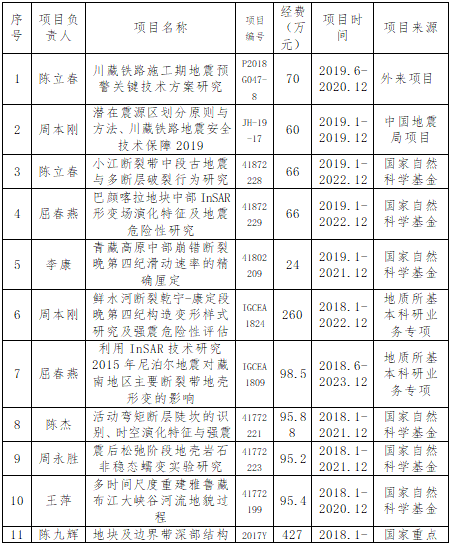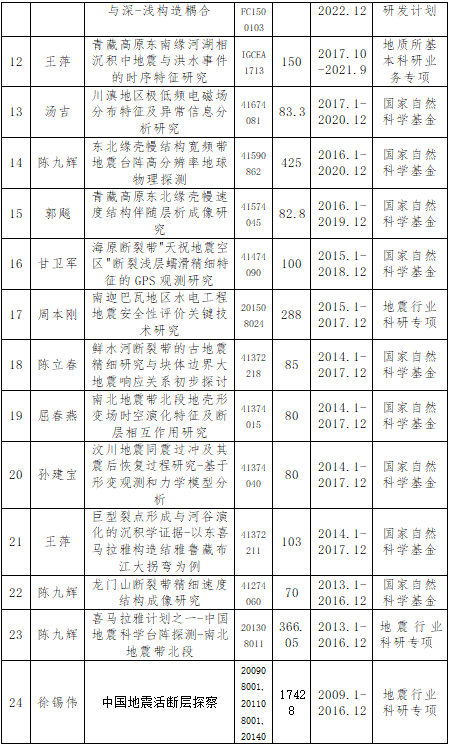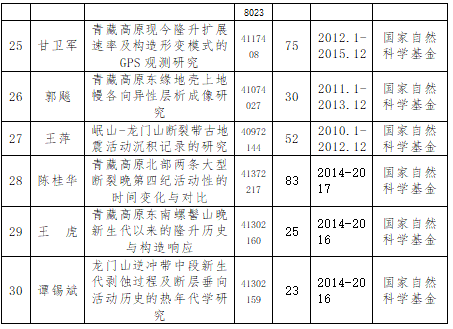西藏拉萨地球物理国家野外科学观测研究站以青藏高原隆升动力学为主要研究方向,主要开展青藏高原深部结构、地壳形变、地震机制和高原隆升动力学、地震活动性及与川藏铁路等重大工程项目相关的活动断裂探测和地震地质灾害评估研究。拉萨观测站会持续提高常规连续地震观测数据、地磁观测数据和地震前兆观测数据的观测水平,坚持面向相关科学研究项目的观测数据共享和国际数据交换,提升小尺度地震台阵的数据观测水平和数据应用水平,达到国家级地震台站的先进水平,目标是将拉萨观测站建设成为数据资源共享,“开放型”地球物理科学研究领域的国家野外观测研究示范站以及地球物理学相关专业本科生和研究生的野外实习基地。
科研项目:



科研成果:
Bi, H., Zheng, W., & Zeng, J. (2019). Application of the Structure from Motion Method in Active Tectonics Research: A Case Study Over the Altyn Tagh Fault. International geoscience and remote sensing symposium.
Chen, J., Froment, B., Liu, Q. Y., & Campillo, M. (2010). Distribution of seismic wave speed changes associated with the 12 May 2008 Mw 7.9 Wenchuan earthquake. Geophysical Research Letters, 37(18).
Chen, L., Ran, Y., Wang, H., Shi, X., Liu, R., & Dong, S. (2013). Paleoseismology and kinematic characteristics of the Xiaoyudong rupture, a short but significant strange segment characterized by the May 12, 2008, Mw 7.9 earthquake in Sichuan, China. Tectonophysics,, 91-101.
Chen, L., Ran, Y., Wang, H., Li, Y., & Ma, X. (2013). The Lushan M S7.0 earthquake and activity of the southern segment of the Longmenshan fault zone. Science Bulletin, 58(28), 3475-3482.
Chen, L, C., Hu, W., Yongkang, R., Shengxue, L., Xi, L., Fuyao, W., ... & Fei, H. (2014). The 2013 Lushan Ms 7.0 Earthquake: Varied Seismogenic Structure from the 2008 Wenchuan Earthquake. Seismological Research Letters, 85(1), 34-39.
Cheng Y , Tang J , Chen X , et al. Crustal structure and magma plumbing system beneath the Puer Basin, southwest China: Insights from three-dimensional magnetotelluric imaging[J]. Tectonophysics, 2019.
Dong, Z., Tang, J., Unsworth, M., & Chen, X. (2015). Electrical resistivity structure of the upper mantle beneath Northeastern China: Implications for rheology and the mechanism of craton destruction. Journal of Asian Earth Sciences,, 115-131.
Gang Hu, Ping Wang, Dehong Li, Jianwei Huang, Huiying Wang, Xiaoyan Yang, Jiafu Zhang, Jie Chen, Menghan Qiu, Aimin Zhang, Lingfan Shi,Landscape change and its influence on human activities in Lhasa basin of central Tibetan plateau since the last deglacial, Quaternary International, 536:1-12. doi.org/10.1016/j.quaint.2019.11.023.
Gao, M., Zeilinger, G., Xu, X., Wang, Q., & Hao, M. (2013). DEM and GIS analysis of geomorphic indices for evaluating recent uplift of the northeastern margin of the Tibetan Plateau, China. Geomorphology,, 61-72.
Gong M , Xu X , Shen Y , et al. Initial rupture processes of the 2008 Mw7.9 Wenchuan, China earthquake: From near-source seismic records[J]. Journal of Asian Earth Sciences, 2019, 173(APR.15):397-403.
Hu, G., Wang, P., Li, D., Huang, J., Wang, H., Yang, X., ... & Shi, L. (2020). Landscape change and its influence on human activities in Lhasa basin of central Tibetan plateau since the last deglacial. Quaternary International,, 1-12.
Jian, H., Wang, L., Gan, W., Zhang, K., Li, Y., Liang, S., ... & Yin, X. (2019). Geodetic Model of the 2017 Mw 6.5 Mainling Earthquake Inferred from GPS and InSAR Data. Remote Sensing, 11(24).
Jiang, F., Chen, X., Zhan, Y., Zhao, G., Yang, H., Zhao, L., ... & Wang, L. (2016). Shifting Correlation Between Earthquakes and Electromagnetic Signals: A Case Study of the 2013 Minxian–Zhangxian M L 6.5 ( M W 6.1) Earthquake in Gansu, China. Pure and Applied Geophysics, 173(1), 269-284.
Jiang, G., Xu, X., Chen, G., Liu, Y., Fukahata, Y., Wang, H., ... & Xu, C. (2015). Geodetic imaging of potential seismogenic asperities on the Xianshuihe-Anninghe-Zemuhe fault system, southwest China, with a new 3-D viscoelastic interseismic coupling model. Journal of Geophysical Research, 120(3), 1855-1873.
Li, K., Xu, X., Tan, X., Chen, G., Xu, C., & Kang, W. (2015). Late Quaternary deformation of the Longquan anticline in the Longmenshan thrust belt, eastern Tibet, and its tectonic implication. Journal of Asian Earth Sciences,, 1-10.
Li, K., Xu, X., Kirby, E., Tang, F., & Kang, W. (2017). Late Quaternary paleoseismology of the Milin fault: Implications for active tectonics along the Yarlung Zangbo Suture, Southeastern Tibet Plateau. Tectonophysics,, 64-72.
Li, K., Kirby, E., Xu, X., Chen, G., Ren, J., & Wang, D. (2019). Rates of Holocene normal faulting along the Dong Co fault in central Tibet, based on 14C dating of displaced fluvial terraces. Journal of Asian Earth Sciences,.
Li Y, et al., Seismogenic structure of the 2016 Ms6.4 Menyuan earthquake and its effect on the Tianzhu seismic gap, Geodesy and Geodynamics (2016), 7, 230e236, http://dx.doi.org/10.1016/j.geog.2016.07.002.
Liang H , Yongsheng Z , Changrong H , et al. Sublithostatic pore fluid pressure in the brittle–ductile transition zone of Mesozoic Yingxiu-Beichuan fault and its implication for the 2008 Mw 7.9 Wenchuan earthquake[J]. Journal of Asian Earth Sciences, 2016, 117(2016).
Liang, S., Gan, W., Shen, C., Xiao, G., Liu, J., Chen, W., ... & Zhou, D. (2013). Three-dimensional velocity field of present-day crustal motion of the Tibetan Plateau derived from GPS measurements. Journal of Geophysical Research, 118(10), 5722-5732.
Liu, Q. Y., Der Hilst, R. D., Li, Y., Yao, H., Chen, J., Guo, B., ... & Li, S. C. (2014). Eastward expansion of the Tibetan Plateau by crustal flow and strain partitioning across faults. Nature Geoscience, 7(5), 361-365.
Liu, S., Xu, X., Klinger, Y., Nocquet, J.‐M., Chen, G., Yu, G., & Jónsson, S. (2019). Lower crustal heterogeneity beneath the northern Tibetan Plateau constrained by GPS measurements following the 2001 Mw7.8 Kokoxili earthquake. Journal of Geophysical Research: Solid Earth , 124, 11,992–12,022.
Kang, W., Xu, X., Oskin, M. E., Yu, G., Luo, J., Chen, G., ... & Wu, X. (2020). Characteristic slip distribution and earthquake recurrence along the eastern Altyn Tagh fault revealed by high-resolution topographic data. Geosphere, 16(1), 392-406.
Kang W , Xu X , Yu G , et al. Differential late-Cenozoic uplift across the Dongjiu-Milin Fault Zone in the Eastern Himalayan Syntaxis revealed by low-temperature thermochronology[J]. Journal of Asian earth ences, 2019, 179(AUG.1):189-199.
Keke Xu, Weijun Gan, Jicang Wu,2019. Pre-seismic deformation detected from regional GNSS observation network: A case study of the 2013 Lushan, eastern Tibetan Plateau (China), Ms 7.0 earthquake,Journal of Asian Earth Sciences,180 doi.org/10.1016/j.jseaes.2019.05.004
Qu, C., Xinjian, S., Yunhua, L., Guohong, Z., Xiaogang, S., Guifang, Z., ... & Yufei, H. (2012). Ground Surface Ruptures and Near‐Fault, Large‐Scale Displacements Caused by the Wenchuan Ms8.0 Earthquake Derived from Pixel Offset Tracking on Synthetic Aperture Radar Images. Acta Geologica Sinica-english Edition, 86(2), 510-519.
Qu, C., Zhang, G., Shan, X., Zhang, G., Song, X., & Liu, Y. (2013). Coseismic deformation derived from analyses of C and L band SAR data and fault slip inversion of the Yushu Ms7.1 earthquake, China in 2010. Tectonophysics,, 119-128.
Qu, C., Shan, X., Xu, X., Zhang, G., Song, X., & Zhang, G. (2013). Near-field motion of the Haiyuan fault zone in the northeastern margin of the Tibetan plateau derived from InSAR permanent scatterers analysis. Journal of Applied Remote Sensing, 7(1), 073507-073507.
Qu C., Shan, X., Zhao, D., Zhang, G., & Song, X. (2017). Relationships between InSAR Seismic Deformation and Fault Motion Sense, Fault Strike, and Ascending/Descending Modes. Acta Geologica Sinica-english Edition, 91(1), 93-108.
Qu C., Ronghu, Z., Xinjian, S., Guohong, Z., Yingfeng, Z., Xiaogang, S., ... & Guifang, Z. (2017). Coseismic and post-seismic deformation fields mapped using satellite radar interferometry and fault slip inversion of the 2015 Mw8.3 Illapel earthquake, Chile. Journal of Geodynamics, 104(104), 36-48.
Qu C., Xinjian, S., Ronghu, Z., Guohong, Z., & Yunhua, L. (2019). An integrated study on the coseismic and post-seismic deformation of the 2010 Yushu earthquake based on InSAR analysis. Journal of Earth System Science, 128(3), 1-15.
Sun, J., Johnson, K. M., Cao, Z., Shen, Z., Burgmann, R., & Xu, X. (2011). Mechanical constraints on inversion of coseismic geodetic data for fault slip and geometry: Example from InSAR observation of the 6 October 2008 Mw 6.3 Dangxiong-Yangyi (Tibet) earthquake. Journal of Geophysical Research,.
Sun, J., Shen, Z., Burgmann, R., Wang, M., Chen, L., & Xu, X. (2013). A three‐step maximum a posteriori probability method for InSAR data inversion of coseismic rupture with application to the 14 April 2010 Mw 6.9 Yushu, China, earthquake. Journal of Geophysical Research, 118(8), 4599-4627.
Sun, J., Yue, H., Shen, Z., Fang, L., Zhan, Y., & Sun, X. (2018). The 2017 Jiuzhaigou Earthquake: A Complicated Event Occurred in a Young Fault System. Geophysical Research Letters, 45(5), 2230-2240.
Wang, H., Chen, L., Ran, Y., Lei, S., & Li, X. (2015). Paleoseismic investigation of the seismic gap between the seismogenic structures of the 2008 Wenchuan and 2013 Lushan earthquakes along the Longmen Shan fault zone at the eastern margin of the Tibetan Plateau. Lithosphere, 7(1), 14-20.
Wang, M., Zhou, B., Yang, X., Xie, C., & Gao, X. (2013). Characteristics of Late-Quaternary Activity and Seismic Risk of the Northeastern Section of the Longmenshan Fault Zone. Acta Geologica Sinica-english Edition, 87(6), 1674-1689.
Wang, P., Scherler, D., Liuzeng, J., Mey, J., Avouac, J., Zhang, Y., & Shi, D. (2014). Tectonic control of Yarlung Tsangpo Gorge revealed by a buried canyon in Southern Tibet. Science, 346(6212), 978-981.
Wang Q , Xu X , Shyu J B H , et al. Viscoelastic behavior of the crust around the Longmenshan Thrust Belt inferred from post-seismic deformation of the 2013 Lushan earthquake, China[J]. Journal of Asian Earth Sciences, 2019, 173(APR.15):386-396.
Xu, X., Tan, X., Yu, G., Wu, G., Fang, W., Chen, J., ... & Shen, J. (2013). Normal- and oblique-slip of the 2008 Yutian earthquake: Evidence for eastward block motion, northern Tibetan Plateau. Tectonophysics,, 152-165.
Xu, X., Wen, X., Han, Z., Chen, G., Li, C., Zheng, W., ... & Liang, M. (2013). Lushan M S7.0 earthquake: A blind reserve-fault event. Science Bulletin, 58(28), 3437-3443.
Xu, X., Xu, C., Yu, G., Wu, X., Li, X., & Zhang, J. (2015). Primary Surface Ruptures of the Ludian Mw 6.2 Earthquake, Southeastern Tibetan Plateau, China. Seismological Research Letters, 86(6), 1622-1635.
Yao Q., Xiwei, X. U., Huilin, X., Chong, X., & Xiaohui, W. (2013). Decomposition and Evolution of Intracontinental Strike-Slip Faults in Eastern Tibetan Plateau. Acta Geologica Sinica-english Edition, 87(2), 304-317.
Yin, X. Z., Chen, J. H., Peng, Z., Meng, X., Liu, Q. Y., Guo, B., & Li, S. C. (2018). Evolution and distribution of the early aftershocks following the 2008 Mw 7.9 Wenchuan earthquake in Sichuan, China. Journal of Geophysical Research: Solid Earth, 123, 7775–7790. https://doi.org/10.1029/2018JB015575
Zhang, Y., Shan, X., Zhang, G., Zhong, M., Zhao, Y., Wen, S., ... & Zhao, D. (2020). The 2016 Mw 5.9 Menyuan Earthquake in the Qilian Orogen, China: A Potentially Delayed Depth‐Segmented Rupture Following from the 1986 Mw 6.0 Menyuan Earthquake. Seismological Research Letters,, 758-769.
Zhao, D., Qu, C., Shan, X., Zuo, R., Liu, Y., Gong, W., & Zhang, G. (2018). Broadscale postseismic deformation and lower crustal relaxation in the central Bayankala Block (central Tibetan Plateau) observed using InSAR data. Journal of Asian Earth Sciences,, 26-41.
Zhao, D., Qu, C., Shan, X., Gong, W., Zhang, Y., & Zhang, G. (2018). InSAR and GPS derived coseismic deformation and fault model of the 2017 Ms7.0 Jiuzhaigou earthquake in the Northeast Bayanhar block. Tectonophysics,, 86-99.
Zhao, D., Qu, C., Shan, X., Burgmann, R., Gong, W., & Zhang, G. (2018). Spatiotemporal Evolution of Postseismic Deformation Following the 2001 Mw7.8 Kokoxili, China, Earthquake from 7 Years of Insar Observations. Remote Sensing, 10(12).
Zhao, D., Qu, C., Shan, X., Gong, W., Zhang, G., & Song, X. (2019). New insights into the 2010 Yushu Mw6.9 mainshock and Mw5.8 aftershock, China, from InSAR observations and inversion. Journal of Geodynamics,, 22-31.
Zuo, R., Qu, C., Shan, X., Zhang, G., & Song, X. (2016). Coseismic deformation fields and a fault slip model for the Mw7.8 mainshock and Mw7.3 aftershock of the Gorkha-Nepal 2015 earthquake derived from Sentinel-1A SAR interferometry. Tectonophysics,, 158-169.
陈为涛,, 甘卫军, 万永革, & 肖根如等. (2013). 青藏高原东北缘4个强震重点监视区库仑破裂应力的近百年变化和危险性分析. 吉林大学学报:地, 43(2), 494-505.
程佳, 徐锡伟, 刘杰. 2013. 2014年鲁甸6.5级地震成因、破裂特征和余震分布特征的库仑应力作用[J]. 地球物理学报, 059(2):556-567.
程佳, 徐锡伟, 甘卫军, 马文涛, 陈为涛, & 张勇. (2012).青藏高原东南缘地震活动与地壳运动所反映的块体特征及其动力来源. 地球物理学报, 055(004), 1198-1212.
程远志, 汤吉, 陈小斌, 董泽义, 肖骑彬, & 汪利波. (2015). 南北地震带南段川滇黔接壤区电性结构特征和孕震环境. 地球物理学报, v.58(11), 107-123.
程远志, 汤吉, 邓琰, & 董泽义. (2016). 云南景谷ms6.6地震震源区深部电性结构及其孕震环境 . 地震地质(2), 352-369,共18页.
程远志, 汤吉, 蔡军涛, 陈小斌, 董泽义, & 汪利波. (2017). 青藏高原东缘川滇构造区深部电性结构特征. 地球物理学报(60), 2441.
邓文泽. 龙门山断裂带精细速度结构的双差层析成像研究[D]. 2013.
邓琰, 汤吉, 阮帅. 三维大地电磁自适应正则化有限内存拟牛顿反演[J]. 地球物理学报, 2019(9).
邓琰, 汤吉. 大地电磁测深方法数据处理进展[J]. 地球物理学进展, 2019(4).
高翔, 郭飚, 陈九辉, et al. 地幔上涌对鄂尔多斯西缘岩石圈的改造:来自远震多尺度层析成像的证据. 地球物理学报, 2018, 061(007):2736-2749.
高明星, 徐锡伟, & 刘少峰. (2013). 西秦岭北缘-拉脊山两侧地貌差异及地貌演化. 地震地质(02), 30-41.
郭飚, 刘启元, 陈九辉, 贺日政, & 李顺成. (2012). 中国大陆及邻区上地幔p波各向异性结构. 地球物理学报, 055(012), 4106-4115.
江敏, 陈九辉, Kuwahara Y , et al. 利用小震震源机制解研究汶川地震后龙门山断裂带中段应力场时空演化[J]. 地震地质, 2018, v.40(02):15-27.
焦裕, 周永胜, 张雷, et al. 流体对石灰岩断层摩擦滑动影响的实验研究%Experimental study on the effect of fluid to friction sliding of limestone fault gouge[J]. 地球物理学报, 062(001):159-171.
康文君, 徐锡伟, 于贵华, et al. 南迦巴瓦峰第四纪隆升期次划分的热年代学证据. 地球物理学报, 059(5):1753-1761.
李长军, 甘卫军, 秦姗兰, et al. 青藏高原东南缘南段现今变形特征研究[J]. 地球物理学报, 2019(12):4540-4553.
李长军, 甘卫军, 秦姗兰, et al. 滇中主要活断层现今活动性研究[J]. 地震研究, 2018, 41(03):41-49+148.
李翠平,王萍,钱达,唐茂云. 雅鲁藏布江大峡谷入口河段最近两期古堰塞湖事件的年龄.地震地质,2015,vol. 37(4): 1136-1146
李东雨, 陈立春, 梁明剑, et al. 鲜水河断裂带乾宁段古地震事件与大震复发行为[J]. 地震地质, 2017(04):3-23.
李康, 徐锡伟, & 谭锡斌. (2013). 龙泉山背斜的地壳缩短与隆升——来自河流阶地变形的证据. 地震地质, 035(001), 22-36.
李晓峰, 王萍, 王慧颖, et al. 雅鲁藏布江大拐弯地区河流地貌参数揭示的地质构造意义[J]. 第四纪研究.
李彦宝, 陈立春, 王虎, et al. 雅鲁藏布江断裂带昂仁段晚第四纪活动证据[J]. 地震地质, 2019(5):1091-1104.
李彦宝, 王虎, 刘华国, et al. 甘孜-玉树断裂当江段地表破裂遗迹与1738年玉树西北地震的讨论. 震灾防御技术, 011(002):207-217.
卢倩云, 郑茜, 孙建宝, et al. 基于新一代雷达卫星InSAR数据检测2015年尼泊尔M_W 7.8级地震的同震形变场[J]. 地球物理学进展, 2015, v.30;No.134(06):79-84.
牛露, 周永胜, 姚文明 等 .2018.高温高压条件下彭灌杂岩的强度对汶川地震发震机制的启示. 地球物理学报,61(5): 1728-1740,doi: 10.6038/cjg2018M0227
屈春燕, 单新建, 张国宏, 徐小波, 宋小刚, & 张桂芳, et al. (2014). 时序insar断层活动性观测研究进展及若干问题探讨. 地震地质, 36(3), 731-748.
屈春燕, 左荣虎, 单新建, 张国宏, 宋小刚, & 刘云华, et al. (2017). 尼泊尔mw7.8地震Insar同震形变场及断层滑动分布 . 地球物理学报(1), 151-162,共12页.
盛传贞, 甘卫军, 梁诗明, 陈为涛, & 肖根如. (2014). 滇西地区gps时间序列中陆地水载荷形变干扰的grace分辨与剔除. 地球物理学报, 57(1), 42-52.
孙鑫喆, 徐锡伟, 陈立春, 谭锡斌, 于贵华, & 李智敏等. (2012). 2010年玉树地震地表破裂带典型破裂样式及其构造意义. 地球物理学报, 055(001), 155-170.
韦伟, 王禹钦, 谢超, 周本刚, 郭志, & 尹昕忠, et al. (2018).西藏米林m6.9级地震及其余震序列地震定位. 科学通报(英文版), 063(015), 1493-1501.
谢超, 周本刚, 李正芳. 东喜马拉雅构造结地貌形态及其构造指示意义. 地震地质, 2017, 039(002):276-286.
谢超, 杨晓平, 黄雄南,东喜马拉雅构造结墨脱断裂晚第四纪活动地质证据的发现[J]. 地震地质, 038(4):1095-1106.
谢超, 周本刚, 李正芳, et al. 墨脱区域滑坡滑带土矿物谱学特征及其工程意义[J]. 光谱学与光谱分析, 2016(36):2270.
徐小波, 屈春燕, 单新建, 张桂芳, 马超, & 庾露等. (2016). Cr-insar与ps-insar联合解算方法及在西秦岭断裂中段缓慢变形研究中的应用. 地球物理学报(8期), 2796-2805.
徐锡伟, 江国焰, 于贵华, 吴熙彦, 张建国, & 李西. (2014).鲁甸6.5级地震发震断层判定及其构造属性讨论. 地球物理学报, 057(009), 3060-3068.
徐锡伟, 程佳, 许冲, 李西, 于贵华, & 陈桂华等. (2014).青藏高原块体运动模型与地震活动主体地区讨论:鲁甸和景谷地震的启示. 地震地质, 036(004), 1116-1134.
徐锡伟, 郭婷婷, 刘少卓, 于贵华, 陈桂华, & 吴熙彦. (2016). 活动断层避让相关问题的讨论. 地震地质(38), 502.
尹昕忠, 周本刚, 陈九辉, 韦伟, 谢超, & 郭志. (2018).西藏米林m6.9地震早期余震时空分布特征. 地球物理学报, 061(006), 2322-2331.
赵盼盼, 陈九辉, Michel Campillo, 刘启元, 李昱, & 李顺成等. (2012). 汶川地震区地壳速度相对变化的环境噪声自相关研究. 地球物理学报, 55(1), 137-145.
赵盼盼, 陈九辉, 刘启元, 郭飚, 李顺成, & 李昱. (2015). 龙门山断裂带中上地壳速度结构的短周期环境噪声成像. 地球物理学报, 058(011), 4018-4030.
曾蒂, 陈立春, 陈顺云, et al. 2013年芦山MS7.0地震前基岩地温变化的再分析. 地震地质, 2017, 039(005):994-1006.
周永胜, 韩亮, 靖晨, 何昌荣, & 党嘉祥. (2014). 龙门山断层脆-塑性转化带流变结构与汶川地震孕震机制. 地震地质, 036(003), 882-895.











 京公网安备 11010502042766号
京公网安备 11010502042766号